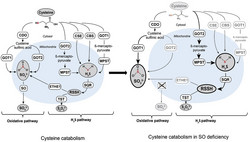The role of glutamate oxaloacetate transaminases in sulfite biosynthesis and H2S metabolism

Abstract:
Molybdenum cofactor deficiency and isolated sulfite oxidase deficiency are two rare genetic disorders that are caused by impairment of the mitochondrial enzyme sulfite oxidase. Sulfite oxidase is catalyzing the terminal reaction of cellular cysteine catabolism, the oxidation of sulfite to sulfate. Absence of sulfite oxidase leads to the accumulation of sulfite, which has been identified as a cellular toxin. However, the molecular pathways leading to the production of sulfite are still not completely understood. In order to identify novel treatment options for both disorders, the understanding of cellular cysteine catabolism – and its alterations upon loss of sulfite oxidase – is of utmost importance. Here we applied a new detection method of sulfite in cellular extracts to dissect the contribution of cytosolic and mitochondrial glutamate oxaloacetate transaminase (GOT) in the transformation of cysteine sulfinic acid to sulfite and pyruvate. We found that the cytosolic isoform GOT1 is primarily responsible for the production of sulfite. Moreover, loss of sulfite oxidase activity results in the accumulation of sulfite, H2S and persulfidated cysteine and glutathione, which is consistent with an increase of SQR protein levels. Surprisingly, none of the known H2S-producing pathways were found to be upregulated under conditions of sulfite toxicity suggesting an alternative route of sulfite-induced shift from oxidative to H2S dependent cysteine catabolism.
Read more at Redox Biology, Volume 38, 2021
